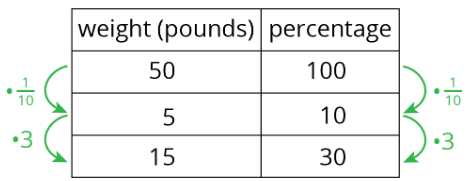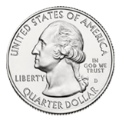18.1: Percentages and Double Number Lines
( \newcommand{\kernel}{\mathrm{null}\,}\)
Lesson
Let's use double number lines to represent percentages.
Exercise 18.1.1: Fundraising Goal
Each of three friends—Lin, Jada, and Andre—had the goal of raising $40. How much money did each person raise? Be prepared to explain your reasoning.
- Lin raised 100% of her goal.
- Jada raised 50% of her goal.
- Andre raised 150% of his goal.
Exercise 18.1.2: Three-Day Biking Trip
Elena biked 8 miles on Saturday. Use the double number line to answer the questions. Be prepared to explain your reasoning.

- What is 100% of her Saturday distance?
- On Sunday, she biked 75% of her Saturday distance. How far was that?
- On Monday, she biked 125% of her Saturday distance. How far was that?
Exercise 18.1.3: Puppies Grow Up
- Jada has a new puppy that weighs 9 pounds. The vet says that the puppy is now at about 20% of its adult weight. What will be the adult weight of the puppy?

- Andre also has a puppy that weighs 9 pounds. The vet says that this puppy is now at about 30% of its adult weight. What will be the adult weight of Andre’s puppy?

- What is the same about Jada and Andre’s puppies? What is different?
Are you ready for more?
A loaf of bread costs $2.50 today. The same size loaf cost 20 cents in 1955.
- What percentage of today’s price did someone in 1955 pay for bread?
- A job pays $10.00 an hour today. If the same percentage applies to income as well, how much would that job have paid in 1955?
Summary
We can use a double number line to solve problems about percentages. For example, what is 30% of 50 pounds? We can draw a double number line like this:

We divide the distance between 0% and 100% and that between 0 and 50 pounds into ten equal parts. We label the tick marks on the top line by counting by 5s (50÷10=5) and on the bottom line counting by 10% (100÷10=10). We can then see that 30% of 50 pounds is 15 pounds.
We can also use a table to solve this problem.

Suppose we know that 140% of an amount is $28. What is 100% of that amount? Let’s use a double number line to find out.

We divide the distance between 0% and 140% and that between $0 and $28 into fourteen equal intervals. We label the tick marks on the top line by counting by 2s and on the bottom line counting by 10%. We would then see that 100% is $20.
Or we can use a table as shown.

Glossary Entries
Definition: Percent
The word percent means “for each 100.” The symbol for percent is %.
For example, a quarter is worth 25 cents, and a dollar is worth 100 cents. We can say that a quarter is worth 25% of a dollar.


Definition: Percentage
A percentage is a rate per 100.
For example, a fish tank can hold 36 liters. Right now there is 27 liters of water in the tank. The percentage of the tank that is full is 75%.

Practice
Exercise 18.1.4
Solve each problem. If you get stuck, consider using the double number lines.
- During a basketball practice, Mai attempted 40 free throws and was successful on 25% of them. How many successful free throws did she make?

- Yesterday, Priya successfully made 12 free throws. Today, she made 150% as many. How many successful free throws did Priya make today?

Exercise 18.1.5
A 16-ounce bottle of orange juice says it contains 200 milligrams of vitamin C, which is 250% of the daily recommended allowance of vitamin C for adults. What is 100% of the daily recommended allowance of vitamin C for adults?

Exercise 18.1.6
At a school, 40% of the sixth-grade students said that hip-hop is their favorite kind of music. If 100 sixth-grade students prefer hip hop music, how many sixth-grade students are at the school? Explain or show your reasoning.
Exercise 18.1.7
Diego has a skateboard, scooter, bike, and go-cart. He wants to know which vehicle is the fastest. A friend records how far Diego travels on each vehicle in 5 seconds. For each vehicle, Diego travels as fast as he can along a straight, level path.
| vehicle | distance traveled |
|---|---|
| skateboard | 90 feet |
| scooter | 1,020 inches |
| bike | 4,800 centimeters |
| go-cart | 0.03 kilometers |
- What is the distance each vehicle traveled in centimeters?
- Rank the vehicles in order from fastest to slowest.
(From Unit 3.3.5)
Exercise 18.1.8
It takes 10 pounds of potatoes to make 15 pounds of mashed potatoes. At this rate:
- How many pounds of mashed potatoes can they make with 15 pounds of potatoes?
- How many pounds of potatoes are needed to make 50 pounds of mashed potatoes?
(From Unit 3.3.3)

